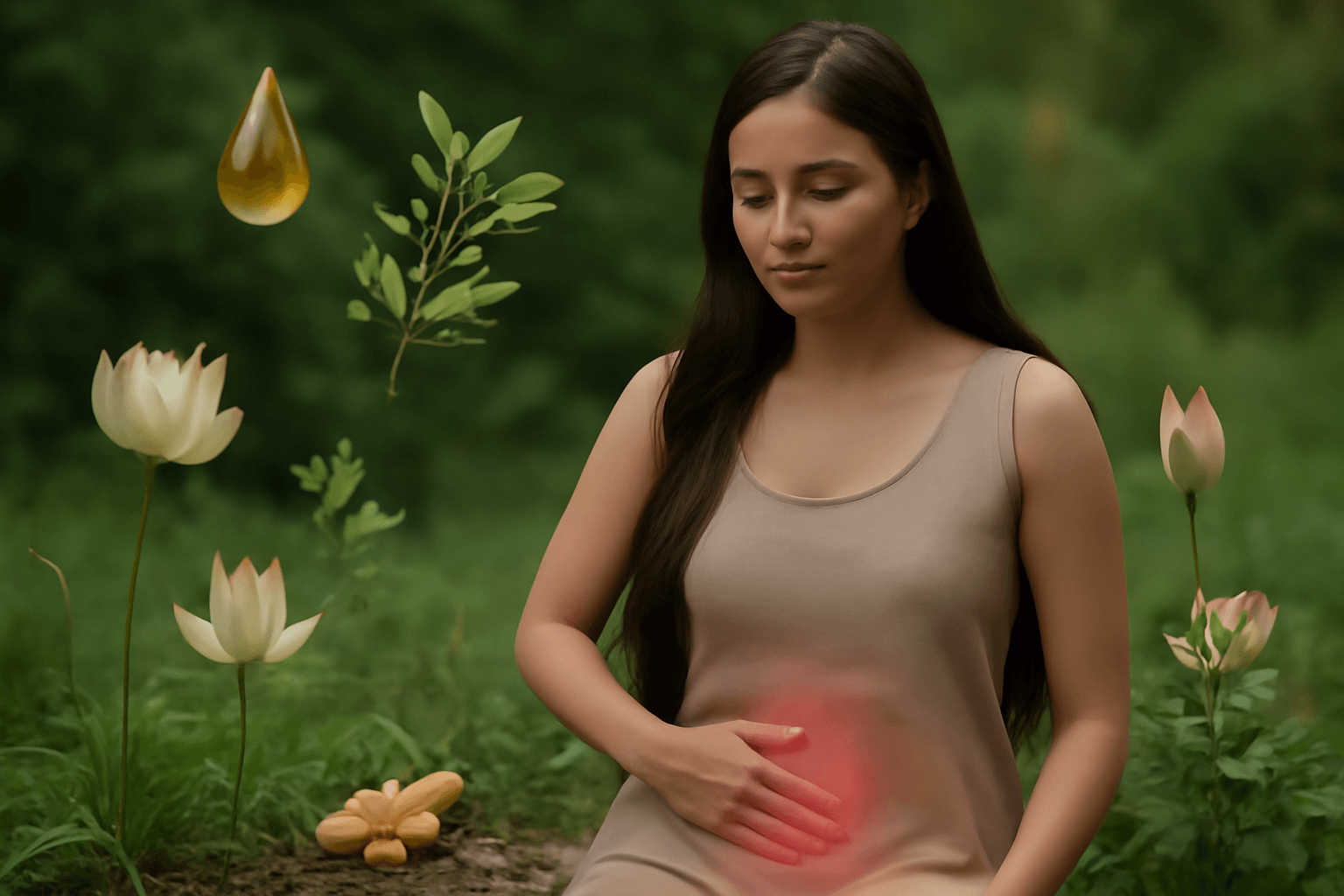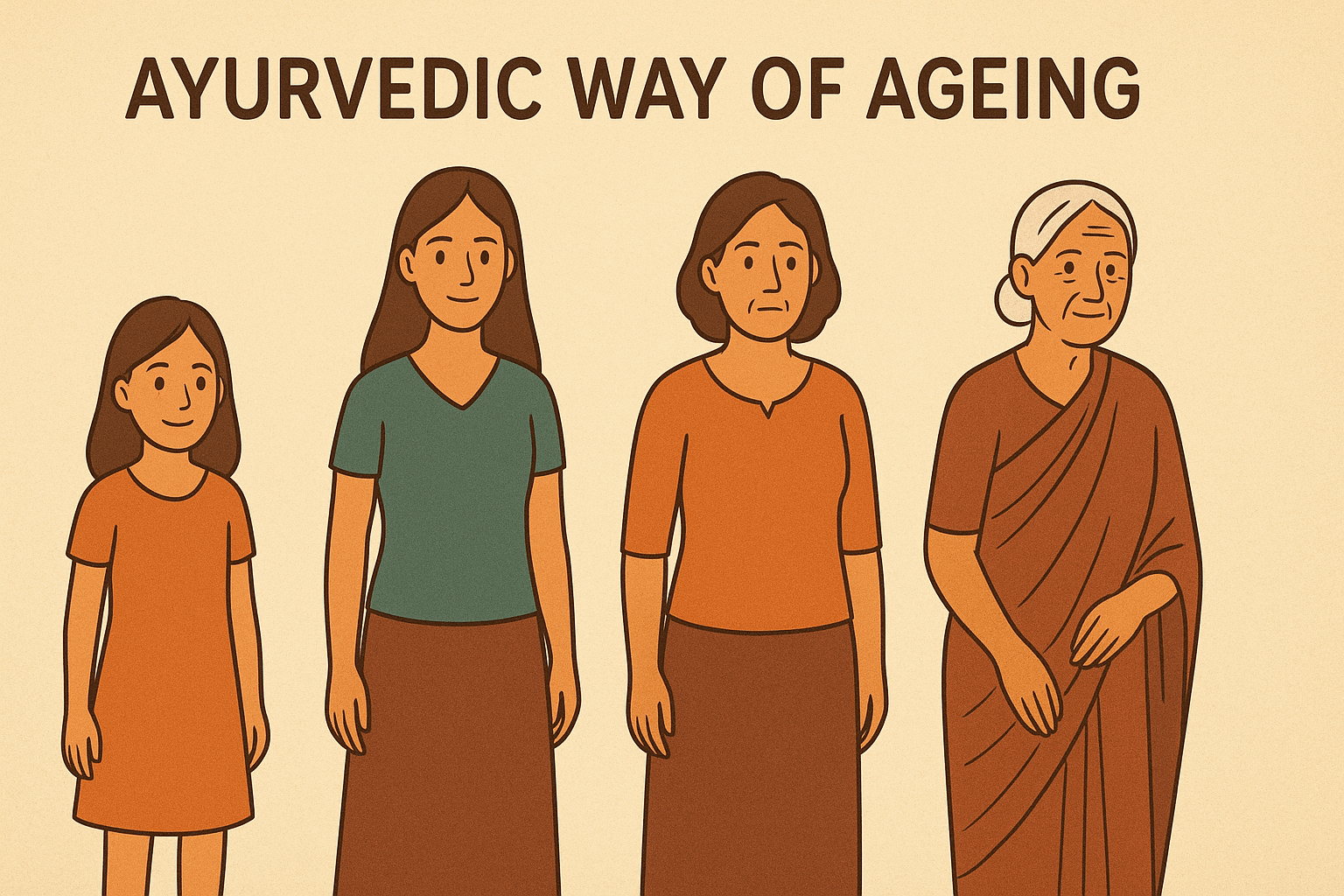UNDERSTANDING MENSTRUATION THROUGH AYURVEDA.
“That time of the month!”
Well, we all know what that means! It’s that dreaded time of the month when moods swing wilder than a roller coaster and cravings make you want to buy out the entire snack aisle. But hey, is it all just about the PMS memes and hot-water bags?
Definitely not!
It’s also that time of the month when your body whispers ‘balance.’
When it says, “I’m in tune with nature.”
A quiet miracle where hormones act disciplined enough to prepare, nurture, and then gently let go of what’s no longer needed.
Modern science calls it the shedding of the uterine lining. The menstruation!
Ayurveda calls it Rituchakra. The sacred wheel of seasons turning within a woman’s body!
Just as nature moves from spring to summer to autumn, a woman’s body also flows through its internal seasons, each phase with its own mood, energy, and purpose. This 28-day cycle is more than just cramps and confusion. Think of it as a woman’s personalised calendar of balance and energy.
Learning to understand this monthly cycle is like unlocking a secret manual to feminine health, not just to survive “that time of the month,” but to thrive through it.
The Whisper of First Blood: An insight into Rituchakra.
Many of us remember that day we noticed a small stain on our clothes and realized, with a mix of curiosity and nervous excitement, that our bodies had stepped into a new chapter. The crimson journey begins with that unforgettable milestone of menarche. It signals the transition from girlhood to womanhood. Typically occurring between 11 and 15 years of age, this first menstruation marks the maturation of the hypothalamo-pituitary-ovarian axis and the readiness of the reproductive system.
Ayurveda reveres this initiation as Prathama Rajodarśana-kāla or Artava Pravritti, which begins at the age of 13, approximately, and ceases around 50. The ceasing period is known as menopause or Rajonivṛtti-kāla.
Ayurveda frames this fertile phase as the Rituchakra, a beautifully timed 28-35 day cycle that echoes the lunar cycle and the gentle turn of seasons. Further, Ayurveda divides this fertile cycle into three more distinct yet harmonious phases, closely paralleling modern science:
- The menstrual phase (Artavasrava)
- The fertile or ovulatory phase (Ritukala/Drishtaartavakala)
- The uterine contraction phase (Yoni Sankochakala).
The Crimson Flow: Rajaśrava-kāla/Artavasrava-kala
This is the first phase of the cycle, aka, the bleeding period or Rajaśrava-kāla.
This is the phase where many of us instinctively crave rest, warm, comforting foods, and quality time with our loved ones. It traditionally lasts about three to seven days. During this time, the body sheds the superficial lining of the uterus, making way for a new cycle.
The Ayurvedic mechanism of menstrual bleeding:
- The blood expelled is considered the physical manifestation of accumulated Artava.
- Artava is the menstrual fluid collected over the month within the uterine vessels (Artavavimocani dhamani).
- This expulsion is orchestrated by the subtle movement of Apānavāta, the downward-moving energy of the body, which guides the flow through the vaginal canal (Yonimukha).
Quality of menstrual blood as a diagnostic tool in Ayurveda:
- Ideally, it should be bright red, similar in shade to fresh lotus petals or ripe pomegranate seeds.
- It should be free from foul smell.
- And it should not stain clothes excessively.
Any deviation in these classical qualities of artavasrava, such as very dark, foul-smelling, scanty, or excessively thick blood, can indicate underlying imbalances of the doshas (Vāta, Pitta, and Kapha).
For instance,
- Excessive dryness, clotting, and sharp pain may suggest Vātaja disturbance.
- Burning sensation with a putrid smell points to Pittaja imbalance.
- Thick, sticky, pale discharge hints at Kaphaja vitiation.
Nutritional guidance during menstruation emphasizes warm, light, and easily digestible foods that soothe the digestive fire, such as herbal teas infused with ginger or cinnamon.
The Bloom of Fertility: Ritukāla
Following menstruation unfolds the most fertile phase of the cycle, known as Ritukāla or the Drishta Artavakāla, lasting approximately twelve days.
The feminine energy peaks here. We feel lighter, more social, and often more confident. Many women notice glowing skin and a naturally uplifted mood, which Ayurveda attributes to the body being at its most nourishing and fertile state.
The Ayurvedic mechanism:
- Ayurveda describes this time as when the Yoni (the vaginal canal) behaves like a blooming lotus.
- It is open and receptive, welcoming the Beeja (sperm) for possible conception.
- It is during this time that sexual union can result in fertilization.
- The woman’s body exhibits signs of readiness: slight breast fullness, a subtle increase in clear cervical mucus, and an uplifted mood.
The Modern Logic:
This phase corresponds with the follicular and proliferative phases in modern physiology, where;
- Ovarian follicles mature under the influence of rising estrogen.
- The uterine lining regenerates.
- Leading to thickening and preparing the uterus to nurture a potential embryo.
Ayurveda emphasizes that during this time, vigorous treatments like Ksharakarma or nasal therapies (Nasya) are contraindicated, honoring the delicate and fertile state.
Nourishing the body during Ritukāla is crucial. Hence, a diet rich in unctuous, easily digestible foods like ghee, cooked grains, and fresh vegetables supports tissue building and hormonal balance. Herbal allies such as Shatavari and Ashoka are also traditionally recommended.
The Gentle Closing: Rituvyātitakāla.
The last phase, Rituvyātitakāla, spans the approximately fourteen days before the next menstruation, aligning with the secretory and luteal phases in modern science.
This is when premenstrual symptoms (PMS) show up for many as slight mood changes, breast tenderness, or feeling a little bloated. Ayurveda sees these as signals of the body working hard to either sustain potential conception or naturally release the lining if conception doesn’t occur.
The Ayurvedic mechanism:
- During this time, the uterus becomes less receptive.
- The vaginal canal constricts. This is described as Yoni Sankocha (closure of the vagina).
- This prevents the entry of sperm and signals the end of fertility for the current cycle.
The modern Logic:
- The corpus luteum secretes progesterone.
- This prepares the endometrium to potentially receive and sustain a fertilized egg.
- If implantation does not occur, hormonal shifts trigger the breakdown of the lining.
- It leads back to menstruation.
Supporting this phase involves calming the mind and body through gentle breathwork (Prāṇāyāma), meditation, and warm, nourishing foods. Herbal supplements, such as licorice root and fennel, can help soothe irritability and digestive disturbances commonly experienced at this time.
When the Cycle Stumbles: Understanding Imbalances.
Just like how a river may encounter rocks and bends, the menstrual cycle, too, can experience imbalances, often reflecting deeper disruptions in bodily and mental harmony.
Ayurveda describes various conditions under the umbrella of;
- Artava Dushti (menstrual blood vitiation) and,
- Yoni Vyāpād (vaginal disorders)
These conditions are both linked to specific doshic disturbances and manifest through distinct symptoms.
Other common menstrual disorders include;
- Delayed or absent menstruation (Artava Kshaya and Nashtartava)
- Excessive bleeding (Artava Ativriddhi), etc.
These conditions may arise from lifestyle factors, chronic stress, irregular eating habits, poor sleep, or from constitutional imbalances and require personalized assessment. And these are topics for detailed discussions in our upcoming blogs.
The Rhythm That Writes Your Story!
Every drop of your cycle carries a message of balance, of strength, of life renewing itself within you. Rituchakra is not just a biological loop; it is our body’s ancient clock, ticking in harmony with the moon, whispering secrets of fertility and emotional truth.
When this rhythm sings in balance, you thrive. Your skin glows, your mind steadies, your emotions flow like a calm river. But when it falters, it is not a curse; it is a call. A call to listen!
Ayurveda and science together give you the map back to that harmony:
Nourish when your body builds.
Release when it sheds.
Protect when it prepares.
And rest when it whispers for quiet.
This is not merely period care; this is self-respect at its deepest level.
Your cycle is your story. So, guard it with love.
Because when a woman flows in tune with her natural rhythm, she creates and she transforms. And that power begins now, with you choosing to honor your flow!







